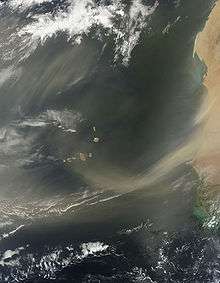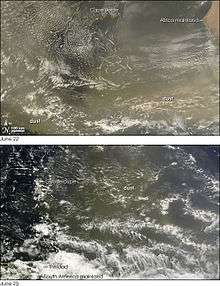Mineral dust

Mineral dust is a term used to indicate atmospheric aerosols originated from the suspension of minerals constituting the soil, being composed of various oxides and carbonates. Human activities lead to 30% of the dust load in the atmosphere. The Sahara Desert is the major source of mineral dust, which subsequently spreads across the Mediterranean (where is the origin of rain dust) and Caribbean seas into northern South America, Central America, North America, and Europe. Additionally, it plays a significant role in the nutrient inflow to the Amazon rainforest.[1] The Gobi Desert is another source of dust in the atmosphere, which affects eastern Asia and western North America.
Characteristics
Mineral dust is mainly constituted of the oxides (SiO2, Al2O3, FeO, Fe2O3, CaO, and others) and carbonates (CaCO3, MgCO3) that constitute the Earth's crust.
Global mineral dust emissions are estimated at 1000-5000 millions of tons per year,[2] of which the largest part is attributed to deserts. Although this aerosol class is usually considered of natural origin, it is estimated that about a quarter of mineral dust emissions could be ascribed to human activities through desertification and land use changes.[3]
Large dust concentrations may cause problems to people having respiratory problems. Another effect of dust clouds is more colorful sunsets.
Saharan dust
The Sahara is the major source on Earth of mineral dust (60-200 millions of tons per year). Saharan dust can be lifted by convection over hot desert areas, and can thus reach very high altitudes; from there it can be transported worldwide by winds, covering distances of thousands of kilometers. The dust combined with the extremely hot, dry air of the Sahara Desert often forms an atmospheric layer called the Saharan Air Layer which has significant effects on tropical weather, especially as it interferes with the development of hurricanes.
There is a large variability in the dust transport across the Atlantic into the Caribbean and Florida from year to year. Due to the trade winds, very large concentrations of mineral dust can be found in the tropical Atlantic, reaching the Caribbean; moreover episodic transport to the Mediterranean region as well as Northern Europe is observed. Saharan plumes can form iberulites (a particular tropospheric aggregation of aerosols) when these plumes travel through North Africa and the eastern North Atlantic Ocean, and often reach the circum-Mediterranean areas of Western Europe. In the Mediterranean region, Saharan dust is important as it represents the major source of nutrients for phytoplankton and other aquatic organisms. Saharan dust carries the fungus Aspergillus sydowii and others.[4] Aspergillus borne by Saharan dust falls into the Caribbean Sea and possibly infects coral reefs with Sea Fan disease (aspergillosis). It also has been linked to increased incidence of pediatric asthma attacks in the Caribbean. Since 1970, dust outbreaks have worsened due to periods of drought in Africa.[5] Dust events have been linked to a decline in the health of coral reefs across the Caribbean and Florida, primarily since the 1970s.[6]
-

Satellite photo of a Saharan dust cloud (2000) over the Eastern Atlantic Ocean.
-

Graph linking dust to various coral deaths across the Caribbean Sea and Florida.
-

Images showing Saharan dust crossing the Atlantic.
Effect on hurricane frequency
According to a NASA article,[7] NASA satellites have shown that "the chilling effect of dust was responsible for one-third of the drop in North Atlantic sea surface temperatures between June 2005 and 2006, possibly contributing to the difference in hurricane activity between the two seasons." There were only 5 hurricanes in 2006 and compared with 15 in 2005.
It is known that one of the major factors that create hurricanes is warm water temperatures on the surface of the ocean. Evidence shows that dust from the Sahara desert caused surface temperatures to be cooler in 2006 than in 2005.
Asian dust
In Eastern Asia, mineral dust events originated in springtime in the Gobi Desert (Southern Mongolia and Northern China) gives rise to the phenomenon called Asian dust. The aerosols are carried eastward by prevailing winds, and pass over China, Korea, and Japan. Sometimes, significant concentrations of dust can be carried as far as the Western United States.[8] Areas affected by Asian dust experience decreased visibility and health problems, such as sore throat and respiratory difficulties. The effects of Asian dust, however, are not strictly negative, as it is thought that its deposition enrichs the soil with important trace minerals.
An American study analyzing the composition of Asian dust events reaching Colorado associates them to the presence of carbon monoxide, possibly incorporated in the air mass as it passes over industrialized regions in Asia. Although dust storms in the Gobi desert have occurred from time to time throughout history, they became a pronounced problem in the second half of the 20th century due to intensified agricultural pressure and desertification.
See also
- Azores High
- Canary Current
- Dust storm
- Dust bowl
- Dust devil
- Iberulites
- Iron fertilization
- Sahel
- Western Hemisphere Warm Pool
References
- ↑ Koren, I.; Kaufman, Y. J.; Washington, R.; Todd, M. C.; Rudich, Y.; Martins, J. V.; Rosenfeld, D. (2006). "The Bodélé depression: a single spot in the Sahara that provides most of the mineral dust to the Amazon forest" (PDF). Environmental Research Letters. 1: 014005. Bibcode:2006ERL.....1a4005K. doi:10.1088/1748-9326/1/1/014005.
- ↑ Huneeus, N.; Schulz, M.; Balkanski, Y.; Griesfeller, J.; Prospero, J.; Kinne, S.; Bauer, S.; Boucher, O.; Chin, M.; Dentener, F.; Diehl, T.; Easter, R.; Fillmore, D.; Ghan, S.; Ginoux, P.; Grini, A.; Horowitz, L.; Koch, D.; Krol, M. C.; Landing, W.; Liu, X.; Mahowald, N.; Miller, R.; Morcrette, J. -J.; Myhre, G.; Penner, J.; Perlwitz, J.; Stier, P.; Takemura, T.; Zender, C. S. (2011). "Global dust model intercomparison in Aero Com phase I". Atmospheric Chemistry and Physics. 11 (15): 7781. Bibcode:2011ACP....11.7781H. doi:10.5194/acp-11-7781-2011.
- ↑ Ginoux, P.; Prospero, J. M.; Gill, T. E.; Hsu, N. C.; Zhao, M. (2012). "Global-scale attribution of anthropogenic and natural dust sources and their emission rates based on MODIS Deep Blue aerosol products". Reviews of Geophysics. 50 (3). Bibcode:2012RvGeo..50.3005G. doi:10.1029/2012RG000388.
- ↑ Schlesinger, P.; Mamane, Y.; Grishkan, I. (2006). "Transport of microorganisms to Israel during Saharan dust events". Aerobiologia. 22 (4): 259. doi:10.1007/s10453-006-9038-7. "On a spring clear day, the persisting airborne fungi were Alternaria alternata, Geotrichum candidum, Penicillium chrysogenum, and P. glabrum. However, during two dust events the fungal population was dominated by Alternaria alternata, Aspergillus fumigatus, A. niger, A. thomii, Cladosporium cladosporioides, Penicillium chrysogenum, and P. griseoroseum. This study suggests that Saharan and other desert dust events in the East Mediterranean have a significant effect on the airborne microbial populations, which might impact on health, agriculture, and ecology."
- ↑ Usinfo.state.gov. Study Says African Dust Affects Climate in U.S., Caribbean. Retrieved on 2007-06-10.
- ↑ U. S. Geological Survey. Coral Mortality and African Dust. Retrieved on 2007-06-10.
- ↑ Sharan Dust has chilling effect on North Atlantic
- ↑ University of Utah Department of Meteorology. Dr. Kevin Perry is quoted in BALTIMORE SUN article, "Blowing in the Wind". Retrieved on 2007-06-10.
- Kubilay and Saydam, "Trace elements in atmospheric particulates over the Eastern Mediterranean: concentration, sources, and temporal variability", Atmospheric Environment 29, 2289-2300 (1995).
- Morales, "The airborne transport of Saharan dust: a review", Climate Change 9, 219-241 (1986).
- Loyë-Pilot et al., "Influence of Saharan dust on the rain acidity and atmospheric input to the Mediterranean", Nature 321, 427-428 (1986).
- Sokolik and Toon, "Direct radiative forcing by anthropogenic airborne mineral aerosols", Nature 381, 681-683 (1996).
- Tegen and Fung, "Contribution to the atmospheric mineral aerosol load from land surface modification", Journal of Geophysical Research 100, 18707-18726 (1995).
- Yücekutlu, N., Terzioğlu, S., Saydam, C., and Bildacı, I., Organic Farming By Using Saharan Soil: Could It Be An Alternative To Fertilizers? Hacettepe J. Biol. and Chem., 39 (1), 29–37, 2011.
External links
- The Dust Hypothesis for Caribbean Coral Bleaching as reported by the United States Geological Survey
- Saharan dust in America
- The Bibliography of Aeolian Research
- High quality video of dust from Sahara to Amazon